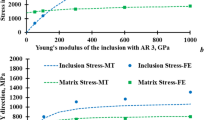Abstract
We describe a method for the approximate solution of nonlinear elasticity problems in the framework of finite deformation for the case of hyperelastic isotropic materials. This method enables one to write the resulting equations from the finite element method in analytical form, which reduces the amount of computations and simplifies the implementation. This approach is implemented for several types of hyperelastic materials used to describe the mechanical behavior of soft biological tissues.
Similar content being viewed by others
References
Cotin, S., Delingette, H., and Ayache N., Real-time elastic deformations of soft tissues for surgery simulation, IEEE Trans. Visualization Comput. Graphics, 1999, vol. 5, no. 1, pp. 62–73.
Székely, G., Brechbühler, C., Hutter, R., et. al., Modelling of soft tissue deformation for laparoscopic surgery simulation, Med. Image Anal., 2000, vol. 4, no. 1, pp. 57–66.
Delingette, H. and Ayache, N., Soft tissue modeling for surgery simulation, Handbook of Numerical Analysis, vol. 12, Amsterdam: North-Holland, pp. 453–550.
Famaey, N. and Sloten, J.V., Soft tissue modelling for applications in virtual surgery and surgical robotics, Comput. Methods Biomech. Biomed. Eng., 2008, vol. 11, no. 4, pp. 351–366.
Delingette, H., Triangular springs for modeling nonlinear membranes, IEEE Trans. Visualization Comput. Graphics, 2008, vol. 14, no. 2, pp. 329–341.
Holzapfel, G.A., Biomechanics of soft tissue, The Handbook of Materials Behavior Models, vol. 3, San Diego: Academic, 2001, pp. 1049–1063.
Martins, P., Natal Jorge, R.M., and Ferreira, A.J.M., A comparative study of several material models for prediction of hyperelastic properties: application to silicone–rubber and soft tissues, Strain, 2006, vol. 42, no. 3, pp. 135–147.
Kim, J., Ahn, B., De, S., and Srinivasan, M.A., An efficient soft tissue characterization algorithm from in vivo indentation experiments for medical simulation, Int. J. Med. Rob. Comput. Assisted Surg., 2008, vol. 4, no. 3, pp. 277–285.
Bonet, J. and Wood, R.D., Nonlinear Continuum Mechanics for Finite Element Analysis, Cambridge: Cambridge Univ. Press, 1997.
Rivlin, R.S., Large elastic deformations of isotropic materials: IV. Further developments of the general theory, Philos. Trans. R. Soc. London, Ser. A, 1948, vol. 241, no. 835, pp. 379–397.
Mihai, L.A., Chin, L., Janmey, P.A., and Goriely, A., A comparison of hyperelastic constitutive models applicable to brain and fat tissues, J. R. Soc., Interface, 2015, vol. 12, no. 110, article id. 20150486.
Chui, C., Kobayashi, E., Chen, X. et. al., Combined compression and elongation experiments and nonlinear modelling of liver tissue for surgical simulation, Med. Biol. Eng. Comput., 2004, vol. 42, no. 6, pp. 787–798.
Horgan, C.O. and Saccomandi, G., A description of arterial wall mechanics using limiting chain extensibility constitutive models, Biomech. Model. Mechanobiol., 2003, vol. 1, no. 4, pp. 251–266.
Horgan, C.O., The remarkable Gent constitutive model for hyperelastic materials, Int. J. Nonlinear Mech., 2015, vol. 68, pp. 9–16.
Ciarlet, P.G., The Finite Element Method for Elliptic Problems, Amsterdam: North-Holland, 1978. Translated under the title Metod konechnykh elementov dlya ellipticheskikh zadach, Moscow: Mir, 1980.
Love, A.E.H., A Treatise on the Mathematical Theory of Elasticity, Cambridge: Cambridge Univ. Press, 1920. Translated under the title Matematicheskaya teoriya uprugosti, Moscow: ONTI, 1935.
Kelley, C.T., Iterative Methods for Linear and Nonlinear Equations, Philadelphia: SIAM, 1995.
Knoll, D.A. and Keyes, D.E., Jacobian-free Newton–Krylov methods: a survey of approaches and applications, J. Comput. Phys., 2004, vol. 193, no. 2, pp. 357–397.
Sharma S., Critical comparison of popular hyper-elastic material models in design of anti-vibration mounts for automotive industry through FEA, Proc. of the Third European Conference on Constructive Models for Rubber, London, 2003, pp. 161–168.
Author information
Authors and Affiliations
Corresponding author
Additional information
Original Russian Text © Yu.V. Vassilevski, V.Yu. Salamatova, A.V. Lozovskiy, 2017, published in Differentsial’nye Uravneniya, 2017, Vol. 53, No. 7, pp. 935–942.
Rights and permissions
About this article
Cite this article
Vassilevski, Y.V., Salamatova, V.Y. & Lozovskiy, A.V. Concise formulas for strain analysis of soft biological tissues. Diff Equat 53, 908–915 (2017). https://doi.org/10.1134/S0012266117070072
Received:
Published:
Issue Date:
DOI: https://doi.org/10.1134/S0012266117070072




